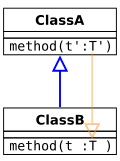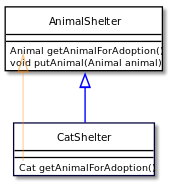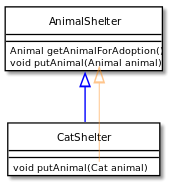Covariance and contravariance
"variance"是type constructor的一个非常重要的属性,本文对此进行描述。
Language designer需要对由type constructor而构建的complex type之间的relation规则进行准确的定义,wikipedia Covariance and contravariance (computer science) 就对这个问题进行了描述,下面是我阅读完这篇文章后所总结的:
对于由**type constructor**构建而成**complex type**,这些**complex type**之间的subtype relation由如下因素决定:
1) type constructor的variance属性
2) complex type的simple type之间的subtype relation
关于此,在wikipedia Covariance and contravariance (computer science) 中有着如下描述:
Depending on the variance of the type constructor, the subtyping relation of the simple types may be either preserved(保留), reversed(反转), or ignored(忽视) for the respective complex types.
"covariance"的含义是"协变","contravariance"的含义是"逆变"。"variance"的含义是"可变","invariance"的含义是"不可变"。
csdn 对协变和逆变的理解(Contravariance and Covariance)
object[] objects = new string[2]; //Java
object[] objects = new string[2]; //C#
这就是**协变**,清注意对象的类型发生了变换,C#和Java都是支持 数组协变 的语言。
我们都知道C#和Java中String类型都是继承自Object的,姑且记做String ≦ Object,表示String是Object的**子类型**,String的对象可以赋给Object的对象。
而Object的数组类型Object[],我们可以理解成是由Object构造出来的一种新的类型, 可以认为是一种构造类型,记f(Object)(可以类比下初中数学中函数的定义),那么我们可以这么来描述**协变**和**逆变**:
- 当
A ≦ B时,如果有f(A) ≦ f(B),那么f叫做协变covariance ; - 当
A ≦ B时,如果有f(B) ≦ f(A),那么f叫做逆变contravariance; - 如果上面两种关系都不成立则叫做
不可变invariant ;
其实顾名思义,**协变**和**逆变**表示的一种类型转变的关系:“构造类型”之间相对“子类型”之间的一种关系。
“协”表示一种自然而然的转换关系,比如上面的String[] ≦ Object[],这就是大家学习面向对象编程语言中经常说的:
子类变量能赋给父类变量,父类变量不能赋值给子类变量。
而“逆”则不那么直观,平时用的也很少,后面讲Java泛型中的协变和逆变会看到例子。
不可变的例子就很多了,比如Java中List< Object >和List< String >之间就是不可变的。
List<String> list1 = new ArrayList<String>();
List<Object> list2 = list1;
这两行代码在Java中肯定是编译不过的,反过来更不可能,C#中也是一样。
那么协变和逆变作用到底是什么呢?我个人肤浅的理解:主要是语言设计的一种考量,目的是为了增加语言的灵活性和能力。
返回值协变和参数逆变
上面提到的Java和C#语言都没有把函数作为一等公民(first-class function),那么那些支持一等函数的语言,即把函数也看做一种类型是如何支持**协变**和**逆变**的以及**里氏原则**的呢?
也就是什么时候用一个函数g能够替代其他使用函数f的地方。答案是:
函数
f可以安全替换函数g,如果与函数g相比,函数f接受更一般的参数类型,返回更特化的结果类型。《维基百科》
这就是是所谓的对输入类型是逆变的而对输出类型是协变的Luca Cardelli提出的规则。
虽然Java是面向对象的语言,但某种程度上它仍然遵守这个规则,见上一节的例子,这叫做返回值协变,Java子类覆盖父类方法的时候能够返回一个“更窄”的子类型,所以说Java是一门可以支持**返回值协变**的语言。
类似参数逆变是指子类覆盖父类方法时接受一个“更宽”的父类型。在Java和C#中这都被当作了方法重载。
可能到这又绕糊涂了,返回值协变和参数逆变又是什么东东?回头看看协变和逆变的理解。把方法当成一等公民:
构造类型:Apple ≦ Fruit
返回值:String ≦ Object
参数:Object ≧ String
以上都是我个人对协变和逆变这两个概念的理解(欢迎拍砖)。
wikipedia Covariance and contravariance (computer science)
Many programming language type systems support subtyping. For instance, if the type Cat is a subtype of Animal, then an expression of type Cat should be substitutable wherever an expression of type Animal is used.
NOTE: 直观感觉是: 将 Liskov substitution principle 进行推广。
Variance refers to how subtyping between more complex types relates to subtyping between their components. For example, how should a list of Cats relate to a list of Animals? Or how should a function that returns Cat relate to a function that returns Animal?
NOTE: variance 所描述的是: 更复杂类型之间的subtyping关系(subtyping between more complex types) 和 它们的component的subtyping关系的关联。上面列举了两个例子来说明这个问题:
1)
Cat和Animal之间有subtyping关系,那list ofCats 和 list ofAnimals之间是否沿用Cat和Animal之间的subtyping关系呢?2)
Cat和Animal之间有subtyping关系,那function that returnsCat和 function that returnsAnimal之间的关系呢?
Depending on the variance of the type constructor, the subtyping relation of the simple types may be either preserved(保留), reversed(反转), or ignored(忽视) for the respective complex types.
NOTE: 这段话的意思是: variance of the type constructor 决定了 complex types 是 preserve、reverse还是ignore "subtyping relation of the simple types"。
**covariance**对应的是: preserved
**contravariance**对应的是: reverse
type constructor其实是一个比较容易理解的概念,下面是下面章节的一些例子:
- list type constructor
- function type constructor
In the OCaml programming language, for example, "list of Cat" is a subtype of "list of Animal" because the list type constructor is covariant. This means that the subtyping relation of the simple types are preserved for the complex types.
NOTE: 这段话以OCaml语言中的 list type constructor 为例,介绍了covariant的含义。
On the other hand, "function from Animal to String" is a subtype of "function from Cat to String" because the function type constructor is contravariant in the parameter type. Here the subtyping relation of the simple types is reversed for the complex types.
NOTE: 这段话以 **function type constructor**为例,介绍了contravariant。
A programming language designer will consider variance when devising(设计) typing rules for language features such as arrays, inheritance, and generic datatypes. By making type constructors covariant or contravariant instead of invariant, more programs will be accepted as well-typed. On the other hand, programmers often find contravariance unintuitive(不直观), and accurately tracking variance to avoid runtime type errors can lead to complex typing rules.
NOTE: 从语言的设计者的角度来进行考虑
Formal definition
Within the type system of a programming language, a typing rule or a type constructor is:
- covariant if it preserves the ordering of types (≤), which orders types from more specific to more generic;
- contravariant if it reverses this ordering;
- bivariant if both of these apply (i.e., both
I<A>≤I<B>andI<B>≤I<A>at the same time);[1] - variant if covariant, contravariant or bivariant;
- invariant or nonvariant if not variant.
The article considers how this applies to some common type constructors.
C# examples
For example, in C#, if Cat is a subtype of Animal, then:
IEnumerable<Cat>is a subtype ofIEnumerable<Animal>. The subtyping is preserved becauseIEnumerable<T>is covariant onT.Action<Animal>is a subtype ofAction<Cat>. The subtyping is reversed becauseAction<T>is contravariant onT.- Neither
IList<Cat>norIList<Animal>is a subtype of the other, becauseIList<T>is invariant onT.
Arrays
NOTE: 略
Covariant arrays in Java and C#
NOTE: 略
Function types
NOTE: 描述function type之间的关系
Languages with first-class functions have function types like "a function expecting a Cat and returning an Animal" (written Cat -> Animal in OCaml syntax or Func<Cat,Animal> in C# syntax).
Those languages also need to specify when one function type is a subtype of another—that is, when it is safe to use a function of one type in a context that expects a function of a different type. It is safe to substitute a function f for a function g if f accepts a more general type of argument and returns a more specific type than g. For example, functions of type Animal -> Cat, Cat -> Cat, and Animal -> Animal can be used wherever a Cat -> Animal was expected. (One can compare this to the robustness principle of communication: "be liberal in what you accept and conservative in what you produce.") The general rule is:
$$
S_{1}\rightarrow S_{2}\leq T_{1}\rightarrow T_{2} \quad if \quad T_{1}\leq S_{1} \quad and \quad S_{2}\leq T_{2}
$$
Using inference rule notation the same rule can be written as: $$ T_{1}\leq S_{1}\quad S_{2}\leq T_{2} \over S_{1}\rightarrow S_{2}\leq T_{1}\rightarrow T_{2} $$
In other words, the → type constructor is contravariant in the input type and covariant in the output type. This rule was first stated formally by John C. Reynolds,[3] and further popularized in a paper by Luca Cardelli.[4]
NOTE: 上述结论是非常重要的
When dealing with functions that take functions as arguments (Higher-order function), this rule can be applied several times.
NOTE: 原文的这段话的后半段是没有读懂的
Inheritance in object-oriented languages
When a subclass overrides a method in a superclass, the compiler must check that the overriding method has the right type.
While some languages require that the type exactly matches the type in the superclass (invariance), it is also type safe to allow the overriding method to have a "better" type. By the usual subtyping rule for function types, this means that the overriding method should return a more specific type (return type covariance), and accept a more general argument (parameter type contravariance).
In UML notation, the possibilities are as follows:
Variance and method overriding: overview
For a concrete example, suppose we are writing a class to model an animal shelter. We assume that Cat is a subclass of Animal, and that we have a base class (using Java syntax)
class AnimalShelter {
Animal getAnimalForAdoption() {
// ...
}
void putAnimal(Animal animal) {
//...
}
}
Now the question is: if we subclass AnimalShelter, what types are we allowed to give to getAnimalForAdoption and putAnimal?
Covariant method return type
In a language which allows covariant return types, a derived class can override the getAnimalForAdoption method to return a more specific type:
class CatShelter extends AnimalShelter {
Cat getAnimalForAdoption() {
return new Cat();
}
}
Among mainstream OO languages, Java and C++ support covariant return types, while C# does not. Adding the covariant return type was one of the first modifications of the C++ language approved by the standards committee in 1998.[5] Scala and D also support covariant return types.
Contravariant method parameter type
Similarly, it is type safe to allow an overriding method to accept a more general argument than the method in the base class:
class CatShelter extends AnimalShelter {
void putAnimal(Object animal) {
// ...
}
}
Not many object-oriented languages actually allow this. C++ and Java would interpret this as an unrelated method with an overloaded name.
Covariant method parameter type
A couple of mainstream languages, Eiffel and Dart[6] allow the parameters of an overriding method to have a more specific type than the method in the superclass (parameter type covariance). Thus, the following Dart code would type check, with putAnimal overriding the method in the base class:
class CatShelter extends AnimalShelter {
void putAnimal(covariant Cat animal) {
// ...
}
}
This is not type safe. By up-casting a CatShelter to an AnimalShelter, one can try to place a dog in a cat shelter. That does not meet CatShelter parameter restrictions, and will result in a runtime error.
NOTE: 上述up-casting所对应的是 Liskov substitution principle ;在基类
AnimalShelter中putAnimal(Animal animal)的入参类型为Animal,因此能够接收dog ,但是这显然是不符合CatShelter的putAnimal(covariant Cat animal)。显然这就是导致了 runtime error 。显然这是Eiffel language层面的问题。
Despite the type safety problem, the Eiffel designers consider covariant parameter types crucial(至关重要的) for modeling real world requirements.[8] The cat shelter illustrates a common phenomenon: it is a kind of animal shelter but has additional restrictions, and it seems reasonable to use inheritance and restricted parameter types to model this. In proposing this use of inheritance, the Eiffel designers reject the Liskov substitution principle, which states that objects of subclasses should always be less restricted than objects of their superclass.
NOTE: 从上面的讨论可以看出,Covariant method parameter type 和 Liskov substitution principle 是无法兼得的。如何兼得呢?在后面的"Avoiding the need for covariant parameter types"章节对此进行了说明。
Another example where covariant parameters seem helpful is so-called binary methods, i.e. methods where the parameter is expected to be of the same type as the object the method is called on(希望parameter和调用method的object的type是同类的). An example is the compareTo method: a.compareTo(b) checks whether a comes before or after b in some ordering, but the way to compare, say, two rational numbers will be different from the way to compare two strings. Other common examples of binary methods include equality tests, arithmetic operations, and set operations like subset and union.
In older versions of Java, the comparison method was specified as an interface Comparable:
interface Comparable {
int compareTo(Object o);
}
The drawback of this is that the method is specified to take an argument of type Object. A typical implementation would first down-cast this argument (throwing an error if it is not of the expected type):
class RationalNumber implements Comparable {
int numerator;
int denominator;
// ...
public int compareTo(Object other) {
RationalNumber otherNum = (RationalNumber)other;
return Integer.compare(numerator * otherNum.denominator,
otherNum.numerator * denominator);
}
}
In a language with covariant parameters, the argument to compareTo could be directly given the desired type RationalNumber, hiding the typecast. (Of course, this would still give a runtime error if compareTo was then called on e.g. a String.)
Avoiding the need for covariant parameter types
NOTE: 当代programming language提出的解决"Covariant method parameter type"问题的方案,它使得programmer能够兼得**apparent benefits of covariant parameters** 和 Liskov substitutability。
Other language features can provide the apparent benefits of covariant parameters while preserving Liskov substitutability.
In a language with generics (a.k.a. parametric polymorphism) and bounded quantification, the previous examples can be written in a type-safe way.[9] Instead of defining AnimalShelter, we define a parameterized class Shelter<T>. (One drawback of this is that the implementer of the base class needs to foresee(预见) which types will need to be specialized in the subclasses.)
class Shelter<T extends Animal> {
T getAnimalForAdoption() {
// ...
}
void putAnimal(T animal) {
// ...
}
}
class CatShelter extends Shelter<Cat> {
Cat getAnimalForAdoption() {
// ...
}
void putAnimal(Cat animal) {
// ...
}
}
Similarly, in recent versions of Java the Comparable interface has been parameterized, which allows the downcast to be omitted in a type-safe way:
class RationalNumber implements Comparable<RationalNumber> {
int numerator;
int denominator;
// ...
public int compareTo(RationalNumber otherNum) {
return Integer.compare(numerator * otherNum.denominator,
otherNum.numerator * denominator);
Another language feature that can help is multiple dispatch. One reason that binary methods are awkward to write is that in a call like a.compareTo(b), selecting the correct implementation of compareTo really depends on the runtime type of both a and b, but in a conventional OO language only the runtime type of a is taken into account. In a language with Common Lisp Object System (CLOS)-style multiple dispatch, the comparison method could be written as a generic function where both arguments are used for method selection.
Giuseppe Castagna[10] observed that in a typed language with multiple dispatch, a generic function can have some parameters which control dispatch and some "left-over"(剩下的) parameters which do not. Because the method selection rule chooses the most specific applicable method, if a method overrides another method, then the overriding method will have more specific types for the controlling parameters. On the other hand, to ensure type safety the language still must require the left-over parameters to be at least as general. Using the previous terminology, types used for runtime method selection are covariant while types not used for runtime method selection of the method are contravariant. Conventional single-dispatch languages like Java also obey this rule: only one argument is used for method selection (the receiver object, passed along to a method as the hidden argument this), and indeed the type of this is more specialized inside overriding methods than in the superclass.
Castagna suggests that examples where covariant parameter types are superior (particularly, binary methods) should be handled using multiple dispatch; which is naturally covariant. However, most programming languages do not support multiple dispatch.
NOTE: Giuseppe Castagna的分析所强调的是: 对于支持covariant parameter types的programming language,应该使用multiple dispatch来保证安全。
Summary of variance and inheritance
| Parameter type | Return type | |
|---|---|---|
| C++ (since 1998), Java (since J2SE 5.0), D | Invariant | Covariant |
| C# | Invariant | Covariant (since C# 9 - before Invariant) |
| Scala, Sather | Contravariant | Covariant |
| Eiffel | Covariant | Covariant |
Generic types
In programming languages that support generics (a.k.a. parametric polymorphism), the programmer can extend the type system with new constructors. For example, a C# interface like IList<T> makes it possible to construct new types like IList<Animal> or IList<Cat>. The question then arises what the variance of these type constructors should be.
There are two main approaches.
1) In languages with declaration-site variance annotations (e.g., C#), the programmer annotates the definition of a generic type with the intended variance of its type parameters.
2) With use-site variance annotations (e.g., Java), the programmer instead annotates the places where a generic type is instantiated.
Declaration-site variance annotations
The most popular languages with declaration-site variance annotations are C# and Kotlin (using the keywords out and in), and Scala and OCaml (using the keywords + and -). C# only allows variance annotations for interface types, while Kotlin, Scala and OCaml allow them for both interface types and concrete data types.
Use-site variance annotations (wildcards)
NOTE: 暂时不去了解
Covariant return type
wikipedia Covariant return type
In object-oriented programming, a covariant return type of a method is one that can be replaced by a "narrower" type when the method is overridden in a subclass. A notable language in which this is a fairly common paradigm is C++.
// Classes used as return types:
class A {
}
class B extends A {
}
// "Class B is narrower than class A"
// Classes demonstrating method overriding:
class C {
A getFoo() {
return new A();
}
}
class D extends C {
//Overriding getFoo() in parent class C
B getFoo() {
return new B();
}
}
csdn Covariant return type
class Shape {
public:
virtual double area() const = 0;
};
class Circle : public Shape {
public:
float area() const; // error! different return type
};
int
main() {
}
在继承关系中,子类覆盖父类的虚函数的时候,必须连返回值类型也完全相同。所以上面这个程序编译是编不过的:
main.cpp:9: error: conflicting return type specified for `virtual float Circle::area() const'
main.cpp:5: error: overriding `virtual double Shape::area() const'








